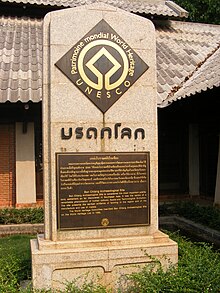| UNESCO World Heritage Site | |
|---|---|
 | |
| Location | Nong Han district, Udon Thani province, Thailand |
| Criteria | Cultural: iii |
| Reference | 575 |
| Inscription | 1992 (16th Session) |
| Area | 30 ha |
| Buffer zone | 760 ha |
| Coordinates | 17°24′25″N 103°14′29″E / 17.4069°N 103.2414°E |
Ban Chiang (Thai: บ้านเชียง, pronounced [bâːn tɕʰīaŋ] ; Northeastern Thai: บ้านเซียง, pronounced [bâːn si᷇aŋ]) is an archaeological site in Nong Han district, Udon Thani province, Thailand. It has been a UNESCO World Heritage Site since 1992. Discovered in 1966, the site first attracted interest due to its ancient red-painted pottery. More recently, it gained international attention in 2008 when the United States Department of Justice, following an undercover investigation begun in 2003, raided several museums for their role in trafficking in Ban Chiang antiquities.
